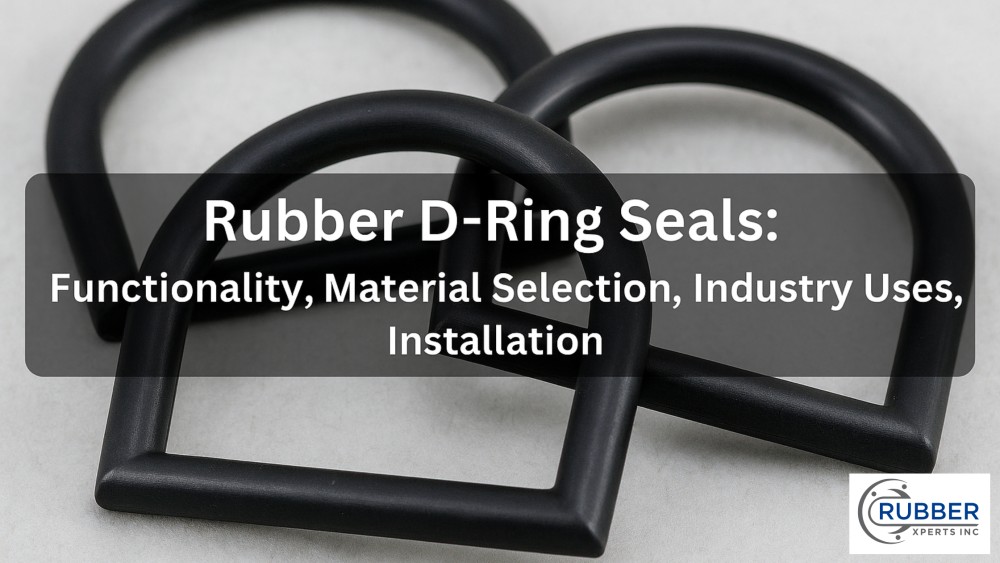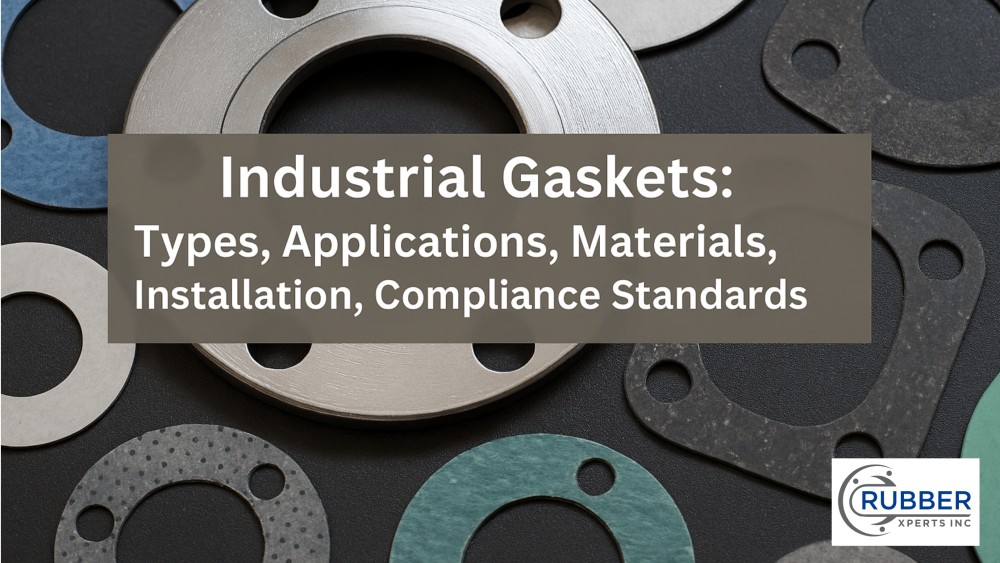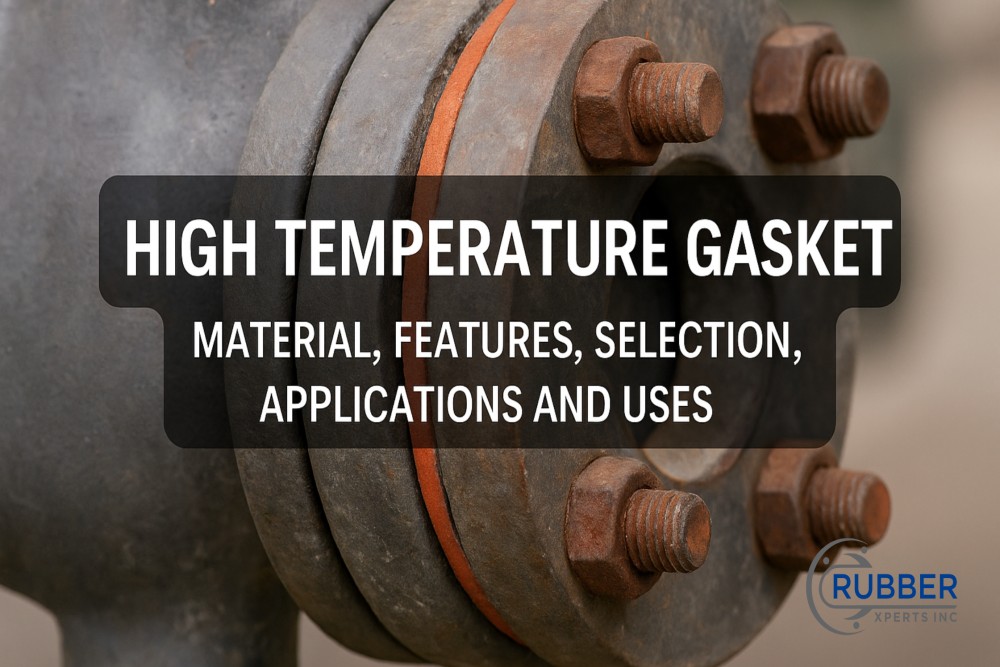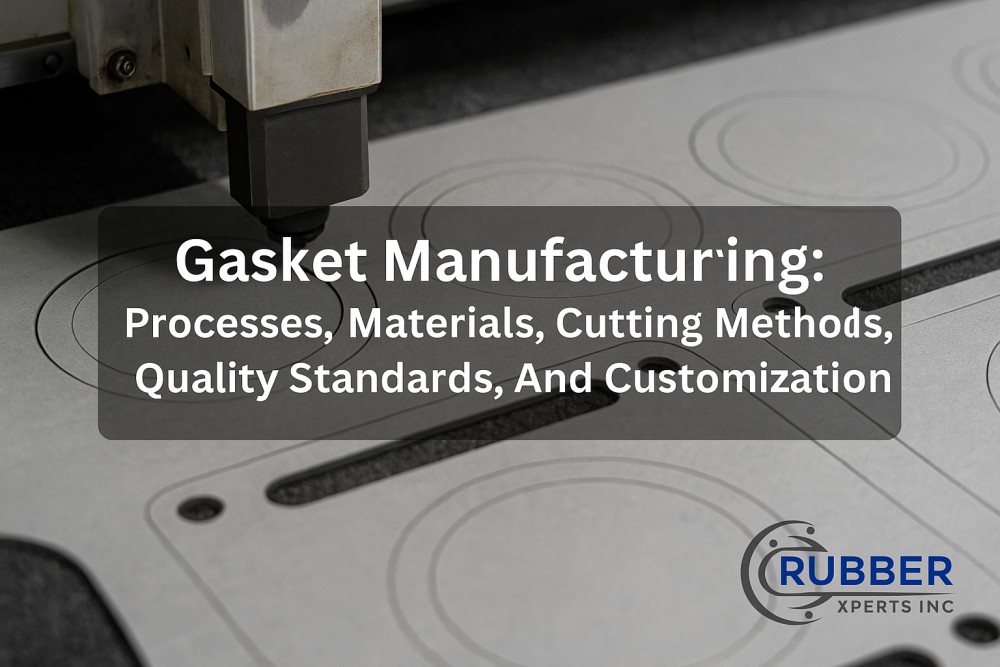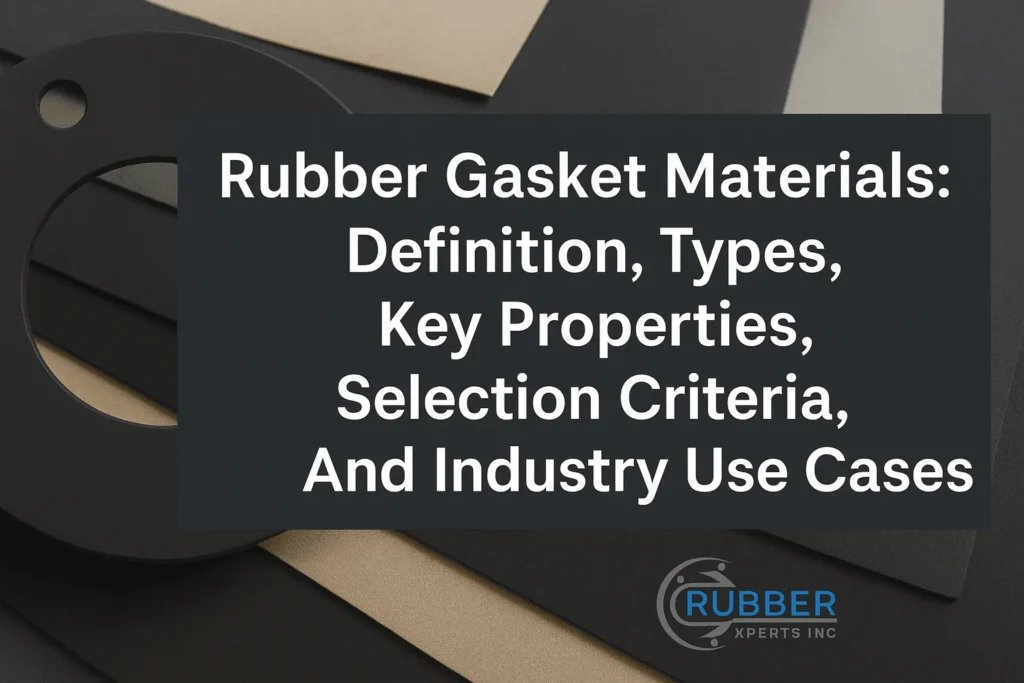Rubber customization involves manufacturing rubber products to meet the unique performance needs of different industries, ensuring they deliver optimal functionality and reliability for specific applications. It is especially important for applications requiring hard rubbers, which offer enhanced durability, resistance, and strength.
Custom rubber manufacturing enables manufacturers to modify rubber components to suit precise functional needs, ensuring high-quality rubber solutions for various uses. According to an IMARC report, the United States rubber market is projected to grow at a CAGR of 5.00% from 2024 to 2032.
The available options for rubber customization include adjustments for hardness, elasticity, and chemical resistance, as well as flexible design choices that ensure the rubber components meet industry standards. Molding techniques, such as compression molding and injection molding, provide precision in shaping rubber products, while vulcanization and extrusion processes ensure structural integrity and durability.
Materials for rubber customization include rubber polymers, elastomeric compounds, thermoplastic elastomers, and additives and fillers. They are carefully selected to optimize the mechanical properties of the rubber. These materials are combined and processed using various methods to create custom rubber blends that meet industry-specific needs, such as automotive parts or seals. The use of reinforcements, such as carbon black or silica fillers, further improves the performance of these customized products.
The applications of rubber customization are found in industries such as automotive, aerospace, healthcare, and construction. Customized rubber parts like seals, gaskets, and hoses ensure performance and longevity in the automotive industry. In healthcare, rubber components such as medical seals and gaskets ensure reliable containment in medical devices. In construction, custom rubber products provide sealing and vibration-damping solutions for structural integrity.
The benefits of rubber customization are immense, including reducing material waste, ensuring optimal performance in harsh conditions, and extending the product’s service life. Manufacturers use rubber customization to create products with enhanced properties suited to specific applications. Adjustments like increased hardness or chemical resistance help rubber products perform efficiently, making customized rubber components more reliable and cost-effective.
Rubber customization offers significant advantages, including configuring products for specific needs, enhancing performance and durability, achieving cost efficiency, and reducing assembly complexity. Manufacturers produce rubber products that meet the specifications for unique applications by utilizing advanced processing methods, including molding, extrusion, and vulcanization. With flexible design options and material modifications, custom rubber solutions help businesses achieve improved efficiency and reduced costs.
What is Rubber Customization?
Rubber customization is the process of designing and manufacturing rubber products customized to meet specific requirements in terms of size, shape, material composition, and performance characteristics. This approach focuses on creating custom rubber products that address unique industrial challenges, such as sealing, vibration control, or load-bearing needs, ensuring optimal performance and durability.
The primary purpose of custom rubbers in industrial sealing is to provide tailored rubber solutions that accommodate diverse environments, pressures, and chemical exposures. Customization allows for the precise modification of rubber properties, such as elasticity, hardness, and resistance to abrasion or heat, enabling the development of personalized rubber components for necessary applications.
Custom rubber products are important for creating effective seals due to their flexible rubber design and capacity for exact fitment, ensuring leak-proof performance in complex systems. Utilizing rubber modification and advanced techniques allows industries to achieve custom elastomers that enhance durability and reliability while addressing specific operational demands.
The various options, techniques, and materials available in rubber manufacturing processes showcase the versatility and importance of industrial rubber applications in sectors like automotive, aerospace, healthcare, and construction. According to IMARC Group, the United States rubber manufacturing market is projected to exhibit a growth rate (CAGR) of 5.00% from 2024 to 2032.
What are the Available Options for Rubber Customization?
The available options for rubber customization include material type, hardness levels, and color customization. These aspects enable rubber design flexibility, offering solutions tailored to specific industrial needs.
The available options for rubber customization are as follows:
Material Type
Selecting the right material is a cornerstone of rubber product customization options. Commonly used rubber materials include natural rubber, synthetic rubbers like neoprene or EPDM, and specialized tailored rubber compounds. Each material offers distinct properties, such as chemical resistance, elasticity, and durability, enabling manufacturers to meet specific environmental or operational requirements.
Hardness Levels
Rubber hardness is adjusted to meet the functional demands of various applications. By modifying the cross-linking density and other factors during manufacturing, rubber is customized to withstand varying loads, resist deformation, or provide a softer, more flexible solution. This flexibility ensures the rubber’s compatibility with applications ranging from seals to vibration dampers.
Color Customization
Color customization provides both aesthetic and functional benefits. Rubber products are manufactured in various colors to align with branding requirements, identify components, or meet regulatory standards. For example, medical-grade rubbers use white or translucent shades, while automotive components prefer black for UV resistance and durability.
Size and Shape
Shape customization involves altering dimensions and geometries to fit precise application needs. Manufacturers use advanced molding techniques to create components that effortlessly integrate into existing systems, whether designing complex rubber seals, large gaskets, or unique profiles. This ensures optimal performance and compatibility.
Surface Texture
Customizing surface texture improves the functional enhancements of rubber products. Smooth textures reduce friction for seals, while roughened surfaces improve grip in industrial or consumer applications. Textures also influence the rubber’s adhesion properties when used with coatings or bonding agents.
Elasticity Strength
Adjusting elasticity provides rubber property adjustments for diverse applications. Higher elasticity is ideal for components like diaphragms or membranes that require extensive stretching, while lower elasticity suits load-bearing products like bushings. Customizing this property ensures performance aligns with operational demands.
Resistance
Resistance is important in rubber customization, ensuring products withstand various environmental and operational challenges. By customizing the composition and structure of rubber, manufacturers improve its ability to endure harsh conditions without compromising functionality or durability. From extreme temperatures to chemical exposure and environmental factors, resistance customization ensures rubber components maintain performance across diverse applications, including automotive, industrial, and marine industries.
The key areas of resistance that are customized in rubber products are as follows:
- Temperature: Rubber is engineered to resist extreme temperatures, making it suitable for high-heat automotive engines or freezing industrial environments. Custom rubber grades designed for temperature resistance ensure long-term durability and prevent material degradation under thermal stress.
- Chemical: Chemical resistance is paramount for rubbers exposed to oils, acids, or other corrosive substances. Adjustments in material composition allow customized rubbers to maintain integrity in harsh chemical conditions, which is necessary for seals and gaskets in chemical processing industries.
- Environmental: Rubbers exposed to sunlight, ozone, or water require environmental resistance. UV-stabilized compounds, ozone-resistant additives, and water-repellent designs extend the lifespan of rubber components in outdoor or marine environments.
Coatings and Fillers
Coatings and fillers provide additional functional enhancements to rubber components. Anti-slip coatings improve grip, while fillers like carbon black enhance strength and UV resistance. These modifications contribute to the durability and performance of the final product, especially in demanding industrial applications.
Specialized Properties
Some rubber products are designed for niche applications with specialized properties such as conductivity, flame retardancy, or antimicrobial resistance. These features expand the versatility of rubber materials, enabling their use in cutting-edge industries like electronics, healthcare, and aerospace.
What are the Different Techniques of Rubber Customization?
The different techniques of rubber customization are molding, extrusion, and calendering. These methods allow manufacturers to create customized rubber products with precise specifications, ensuring optimal application performance. Each technique has unique processes and benefits that cater to specific industrial needs, enhancing today’s custom rubber processing techniques.
The different techniques of rubber customization are as follows:
Molding
Molding is a widely used rubber fabrication method that shapes rubber into desired forms using molds. The process involves placing raw rubber material into a mold cavity and applying heat and pressure to cure it. This technique is highly versatile, enabling the creation of complex geometries, tight tolerances, and consistent product quality. Rubber molding techniques are commonly employed in industries requiring seals, gaskets, and other precision parts due to their excellent durability and repeatability.
What are the Types of Rubber Molding Techniques?
The types of rubber molding techniques are compression, transfer, and injection. Each method offers distinct advantages suited to different applications and product requirements.
The types of molding techniques are as follows:
- Compression molding involves placing a pre-measured amount of rubber into a heated mold cavity and applying pressure to shape the material. This method is cost-effective and suitable for large, simple components like seals and pads.
- Transfer molding uses a chamber to preheat the rubber before it is pushed into a mold cavity. This technique minimizes waste and enables the creation of intricate designs, making it ideal for parts with embedded components.
- Injection molding involves heating the rubber and injecting it into a mold at high pressure. This method is known for its speed and precision, making it perfect for producing complex parts in high volumes, such as O-rings and gaskets.
Extrusion
Extrusion is a rubber customization technique that forces the rubber through a die to create continuous profiles with specific cross-sections. The process utilizes heat and pressure to shape the material, making it ideal for producing hoses, tubing, and seals. The rubber extrusion process is valued for its efficiency, ability to handle various material types, and suitability for long products requiring uniformity.
What are the Types of Rubber Extrusion Techniques?
The types of rubber extrusion techniques are hot rubber extrusion, cold rubber extrusion, and solid rubber extrusion. These methods cater to different material properties and application requirements.
The types of extrusion techniques are as follows:
- Hot Rubber Extrusion: Hot extrusion involves heating rubber to its optimal processing temperature, between 120°C and 200°C, to enhance its plasticity and flow characteristics. This process ensures smoother material flow through the die, reducing strain on machinery and minimizing defects. Hot extrusion is particularly effective for creating products like automotive seals, gaskets, and hoses, where flexibility and resilience under heat are required. The process is widely employed in industries like automotive and construction, where heat-resistant elastomers are important for long-term performance.
- Cold Rubber Extrusion: Cold extrusion operates at ambient or slightly high temperatures, utilizing the rubber’s inherent elasticity without altering its molecular structure through heat. This technique is ideal for preserving the material’s original physical and chemical properties, including tensile strength and elasticity. Cold extrusion is commonly used for high-precision applications such as medical tubing, electrical insulation, and industrial gaskets, where material integrity and dimensional accuracy are paramount. It also consumes less energy than hot extrusion, aligning with sustainable manufacturing practices.
- Solid Rubber Extrusion: Solid rubber extrusion focuses on producing continuous profiles with high density and durability. The process suits applications requiring robust mechanical properties, such as automotive belts, industrial seals, and heavy-duty gaskets. Solid extrusion involves materials like EPDM (ethylene propylene diene monomer), NBR (nitrile butadiene rubber), and neoprene, which offer excellent wear resistance, load-bearing capacity, and chemical resistance. This process ensures that the final product withstands significant stress and environmental challenges.
- Sponge Rubber Extrusion: Sponge rubber extrusion uses a chemical blowing agent to create a lightweight, cellular structure with excellent compression and cushioning properties. This technique creates seals, weatherstripping, and padding for automotive, aerospace, and consumer applications. Sponge rubber exhibits a unique combination of flexibility and shock absorption, making it indispensable for vibration isolation and environmental sealing. The cellular structure also provides thermal and acoustic insulation, adding versatility.
- Custom Rubber Extrusion: Custom extrusion provides the ultimate flexibility in customizing rubber profiles to meet specific industrial requirements. This process involves material composition, shape, and size modifications to create highly specialized components such as multi-channel seals, coiled tubing, and custom gaskets. Industries such as aerospace, healthcare, and energy rely on custom rubber extrusion for solutions that combine unique design elements with high performance. Innovations in polymer science, such as using hybrid elastomers, further improve the scope of custom extrusions for extreme environments.
- Co-Extrusion: Co-extrusion enables the simultaneous extrusion of two or more rubber materials into a single profile. This process creates components with distinct properties in different sections, such as a hard outer layer for wear resistance and a soft inner layer for cushioning. Co-extrusion is commonly used in products like automotive door seals, which require a combination of rigidity and flexibility. Advanced machinery and precise control over material flow ensure smooth layer integration, maintaining structural integrity and performance across various operating conditions.
Calendering
Calendering is a processing technique that passes rubber through rollers to create thin, uniform sheets or coated fabrics. This method produces conveyor belts, roofing materials, and liners. It ensures precise thickness control and enhances the durability of elastomers for demanding applications.
Mixing and Compounding
Mixing and compounding combine raw rubber with additives such as fillers, plasticizers, and curing agents to achieve desired rubber property adjustments. This process improves characteristics like tensile strength, elasticity, and chemical resistance. The technique is important for custom rubber grades customized to specific applications in industries like automotive and healthcare.
Vulcanization
Vulcanization is a process where rubber is treated with heat and sulfur to improve its strength, elasticity, and durability. This technique converts raw rubber into a more stable material suitable for various applications. Vulcanization methods are necessary to produce robust, long-lasting rubber products in the automotive, aerospace, and industrial sectors.
Surface Treatment
Surface treatment involves altering the outer layer of rubber components to improve their functional enhancements. Techniques such as plasma treatment, coating, or roughening improve adhesion, resistance, and surface properties. This customization is important for applications like seals, hoses, and gaskets, where performance and reliability are paramount.
Die Cutting
Die cutting uses a specialized die press to shape rubber into precise forms. This technique is highly efficient for producing gaskets, seals, and other flat components with consistent dimensions. Die cutting offers excellent accuracy, scalability, and versatility, making it a preferred method for customizing rubber solutions in various industries.
What are the Materials Used in Rubber Customization?
The materials used in rubber customization are rubber polymers, reinforcementmaterials, and elastomeric compounds, which collectively enable tailoredperformance for diverse industrial applications. Together, these materials create versatile and high-performance solutions for multiple applications.
The materials used in rubber customization are as follows:
Rubber Polymers
Rubber polymers, the foundational materials in rubber customization, are natural or synthetic compounds with elastomeric properties. Natural rubber is derived from latex, a milky secretion from rubber trees, while synthetic rubbers, like SBR (styrene-butadiene rubber) and NBR (nitrile butadiene rubber), are produced through polymerization processes.
Rubber polymers are popular for their elasticity, tensile strength, and resistance to wear. They are important in industries like automotive and aerospace, where flexibility and durability under various stress conditions are required. Rubber polymers are customized to create rubber blends that cater to specific industrial requirements, such as chemical resistance or low-temperature flexibility.
Reinforcement Materials
Reinforcement materials, such as carbon black and silica fillers, are integrated into rubber compounds to enhance their mechanical properties. Carbon black improves tensile strength, abrasion resistance, and UV stability, making it indispensable for tires and industrial belts.
Silica fillers, on the other hand, offer lower rolling resistance and improved wet traction, which are necessary for energy-efficient tires. These materials also modify rubber’s hardness and elasticity, enabling tailored solutions for diverse applications. Reinforcement materials boost rubber’s performance in demanding environments, including heavy machinery and outdoor sealing applications.
Elastomeric Compounds
Elastomeric compounds are blends of rubber raw materials with additives such as plasticizers, vulcanizing agents, and antioxidants. They are designed to achieve specific properties, such as enhanced flexibility, heat resistance, or chemical stability.
The process involves carefully mixing and processing ingredients to create rubber suitable for specialized applications, such as medical devices, seals, and gaskets. Elastomeric compounds provide unparalleled versatility in rubber customization, allowing industries to meet stringent performance requirements while maintaining cost efficiency.
Thermoplastic Elastomers
Thermoplastic elastomers (TPEs) are specialty rubber materials that combine the elasticity of rubber with the ease of processing plastics. Unlike traditional rubbers, TPEs are melted and reshaped, making them recyclable and cost-effective. These materials are used in consumer goods, automotive parts, and medical tubing due to their excellent flexibility, chemical resistance, and durability.
TPEs are produced through advanced polymerization techniques, creating compounds that deliver consistent performance across various applications. Their ability to be reused and customized for specific needs makes them a sustainable option in modern rubber manufacturing.
What are the Applications of Rubber Customization?
The applications of rubber customization include automotive, aerospace, and healthcare. In these industries, customized rubber solutions are paramount for optimizing performance and meeting specific requirements.
The applications of rubber customization are as follows:
Automotive Industry
Rubber customization is pivotal in the automotive sector, and custom automotive rubber parts like seals and gaskets are manufacturers. These parts are designed for enhanced durability, weather resistance, and vibration damping, ensuring the longevity and safety of vehicles.
Custom rubber products in automotive applications are engineered to withstand extreme temperatures, road conditions, and mechanical stress, improving overall vehicle performance and reliability.
In 2024, the global automotive rubber customized components market was valued at USD 57.4 billion. According to IMARC Group, this market is projected to grow at a CAGR of 4.3% from 2025 to 2033, reaching an estimated USD 84.2 billion by 2033.
Aerospace and Defense
Rubber customization is necessary in the aerospace and defense industries, where components must meet rigorous safety, reliability, and performance standards. Custom rubber solutions are used in sealing applications, vibration damping, and fuel systems.
Marine-grade rubber is resistant to harsh environmental conditions, and heat-resistant elastomers are commonly used in aerospace and defense for parts like gaskets, seals, and O-rings. These materials ensure operational efficiency and safety in demanding systems.
According to a report by IndustryARC, the Aerospace & Defense Elastomers Market is projected to reach $85 million by 2025, growing at a CAGR of 6.1% between 2020 and 2025. The increasing adoption of elastomer-based products in aerospace and defense applications drives this rising demand.
Construction
Rubberized products provide protection, flexibility, and insulation in the construction industry. Customized rubber solutions, such as sealing materials, weatherproofing, and vibration-damping components, help maintain the integrity and durability of buildings and infrastructure.
Rubber applications in construction also include flooring, expansion joints, and protective linings, which enhance safety and comfort while improving the longevity of structures. According to a Facts and Factors Research report, the global industrial rubber market was valued at USD 31.10 billion in 2021 and is projected to grow to USD 37.65 billion by 2028.
Electrical and Electronics
Custom rubber products are used in electrical and electronics industries for insulation, sealing, and protection. Rubber materials designed for electrical applications ensure safety by preventing short circuits, moisture infiltration, and external damage.
Custom rubber components, such as electrical insulation, rubber gaskets, and seals, help extend the lifespan of electronic devices, reducing the risk of failure and enhancing performance under varying environmental conditions.
According to Grand View Research, the global conductive silicone rubber market was valued at USD 6.65 billion in 2022 and is projected to grow at a CAGR of 8.0% from 2023 to 2030.
Healthcare Uses
Rubber customization is integral to the healthcare industry, where specific properties like biocompatibility, flexibility, and sterility are required. To ensure safety and performance, healthcare rubber products, including medical seals, gaskets, and tubing, are made from food-safe rubber materials and elastomers.
Custom rubber formulations are used in medical devices and pharmaceutical packaging to prevent contamination, enhance durability, and comfort patients and healthcare professionals.
According to Grand View Research, the global medical-grade silicone rubber market was valued at USD 738.9 million in 2024 and is projected to grow at a CAGR of 6.8% from 2025 to 2030.
Consumer Products
Rubber customization is used to develop consumer products that require specific durability, elasticity, and texture. Rubber components in everyday items such as footwear, sporting goods, and household products offer functional and aesthetic benefits. Customized rubber solutions allow for the creation of comfortable, durable, and safe consumer products, with specific attention to material strength, flexibility, and resistance to wear and tear.
What are the Benefits of Rubber Customization?
The benefits of rubber customization are customized functionality, performance improvements, and cost-effective solutions to meet specific industry needs. Customizing rubber properties such as hardness, elasticity, and resistance enhances performance, durability, and reliability. This approach ensures optimized functionality, minimizes waste, improves manufacturing processes, and saves costs.
The benefits of rubber customization are as follows:
Configured for Specific Needs
One major benefit of rubber customization is the ability to design rubber products customized to specific applications. Whether it’s custom rubber seals for automotive engines or specialized gaskets for the aerospace industry, rubber customization allows for creating components designed to meet precise functional and environmental requirements.
Application-specific rubber design allows manufacturers to tailor each product to perform optimally in its intended environment, thereby enhancing overall system reliability. Rubber seals benefit significantly from application-specific rubber design, ensuring a precise fit and reliable performance, effectively preventing leaks, and extending the lifespan of components exposed to demanding conditions.
Performance and Durability
Customized rubber solutions significantly improve performance and durability compared to standard rubber products. For instance, custom rubber compounds used in O-rings for industrial equipment enhance sealing performance, resist wear and tear, and withstand extreme temperatures.
Modifying material properties such as hardness, elasticity, and resistance to chemicals or environmental stress improves the performance and service life of customized rubber products, including rubber pipes. These enhancements eventually reduce maintenance needs and minimize downtime for challenging applications.
Cost Efficiency
Rubber customization also offers cost-effective rubber solutions by reducing material waste, improving production efficiency, and delivering products that require fewer modifications during assembly. Manufacturers avoid additional processing steps and unnecessary materials by producing rubber components with application-specific properties, such as specific hardness levels or optimized sizes.
This leads to cost savings and ensures that each rubber product is produced with minimal waste, benefiting both the manufacturer and the environment. O-rings, for example, greatly benefit from this efficiency, as their precise material composition reduces the excess and ensures optimal sealing performance in demanding applications.
Reduced Assembly Complexity
Customized rubber products also simplify the assembly process by eliminating the need for additional components or modifications. For example, rubber gaskets designed to fit perfectly without the need for extra seals or adhesives reduce the complexity of assembly in automotive or industrial applications.
This integrated approach leads to faster assembly times, fewer components, and less labor, eventually improving production efficiency while maintaining high-quality standards.
Why Choose Customized Rubber Products?
You should choose customized rubber products because they offer application-specific performance, enhanced durability, and cost-effective solutions that meet unique industry requirements. Custom rubber products are designed to address exceptional challenges, ensuring optimal functionality in demanding applications, whether in automotive, aerospace, or healthcare.
Customized rubber products allow manufacturers to fine-tune material properties such as hardness, elasticity, and resistance to chemicals or environmental stress, ensuring that each product performs its best throughout its service life. The ability to customize also ensures higher reliability, greater longevity, and a more efficient design, which reduces waste and overall production costs.
What are the Most Popular Customized Rubber Products?
The most popular customized rubber products are O-rings, gaskets, and seals, alldesigned and manufactured to meet specific functional needs in various industries. They are produced for applications where precision, durability, and performance are non-negotiable, from the automotive to industrial sectors. Customization ensures that these products meet the exact requirements for sealing, vibration damping, and chemical resistance, among other critical functions.
The most popular customized rubber products are as follows:
- O-rings: O-rings are among the most widely used rubber products, particularly in sealing applications for the automotive, aerospace, and oil and gas industries. They are custom-made to fit specific grooves and tolerances, providing reliable sealing under high pressure, temperature, and chemical exposure. Custom O-rings ensure superior performance and a longer service life, reducing the risk of leakage and system failures.
- Gaskets: Gaskets are important for creating leak-proof seals between two surfaces in various mechanical systems. Customized gaskets are designed to withstand extreme conditions such as high temperatures, pressure, and exposure to corrosive chemicals. Rubber gaskets are used in machinery, HVAC systems, automotive engines, and fluid systems, providing reliable sealing and helping to maintain operational efficiency.
- Seals: Custom seals prevent leakage in systems that require pressure, fluid, or gas containment. They are made from rubber materials customized to meet specific environmental conditions, such as UV exposure, temperature variations, or moisture resistance. Custom seals are prevalent in the automotive, marine, and aerospace industries, ensuring that components like engines, pumps, and valves function properly without leakage.
- Pipes: Custom rubber pipes are used in industries like construction, agriculture, and manufacturing, where flexible, durable piping is needed for fluid or gas transportation. Rubber pipes are customized for high-pressure applications, temperature resistance, and chemical exposure, ensuring reliable performance in diverse environments.
- Mounts: Rubber mounts reduce vibration and absorb shock in automotive and industrial applications. Custom rubber mounts are designed to meet specific load-bearing and damping requirements, offering enhanced durability and performance in machinery, engines, and vehicles.
- Hoses: Custom rubber hoses are important in fluid and gas transfer applications. They are designed to withstand pressure, temperature fluctuations, and chemical exposure, making them ideal for automotive, aerospace, and manufacturing industries. Custom hoses provide flexibility and durability, reducing the risk of system failures.
- Bushings: Rubber bushings provide cushion and reduce friction between two components. They fulfill specific load-bearing and vibration-damping requirements. Rubber bushings are commonly used in automotive suspensions, machinery, and electrical components to ensure smooth operation and minimize wear.
- Grommets: Custom rubber grommets protect wires, cables, and hoses from abrasion and damage when passing through holes in metal or other materials. These rubber grommets provide a durable, flexible interface that prevents wear and tear while maintaining a secure fit.
- Bellows: Custom rubber bellows are used in applications where movement or expansion must be accommodated while maintaining a sealed environment. These flexible, durable bellows are found in machinery, automotive components, and HVAC systems and protect against dust, moisture, and contaminants.
- Diaphragms: Rubber diaphragms separate chambers and maintain pressure in pumps, valves, and other fluid control systems. Custom diaphragms are designed for specific pressure, temperature, and chemical resistance requirements, ensuring precise control and durability in demanding applications.
Can We Make Customized Rubbers from Eco-Friendly Materials?
Yes, we can make customized rubber products from eco-friendly materials. With advancements in material science, manufacturers now produce rubber compounds using renewable resources or sustainable practices, such as bio-based rubbers or recycled rubber.
These eco-friendly materials offer performance characteristics similar to traditional synthetic rubbers while minimizing environmental impact. The growing demand for sustainable solutions in industries like automotive and healthcare has driven innovations in eco-friendly rubber production, ensuring that businesses meet environmental regulations and consumer preferences without compromising quality or performance.
Where to Get Customized Rubber Products?
You can get customized rubber products from specialized manufacturers like RubberXperts. Reputed rubber manufacturers offer a range of customized rubber solutions for various industries, ensuring that each product meets the application’s specific needs.
Every reliable manufacturer of customized rubber products provides expertise in rubber design, materials, and manufacturing processes. They deliver high-quality, durable rubber products engineered for optimal performance in automotive, industrial, and healthcare applications.

